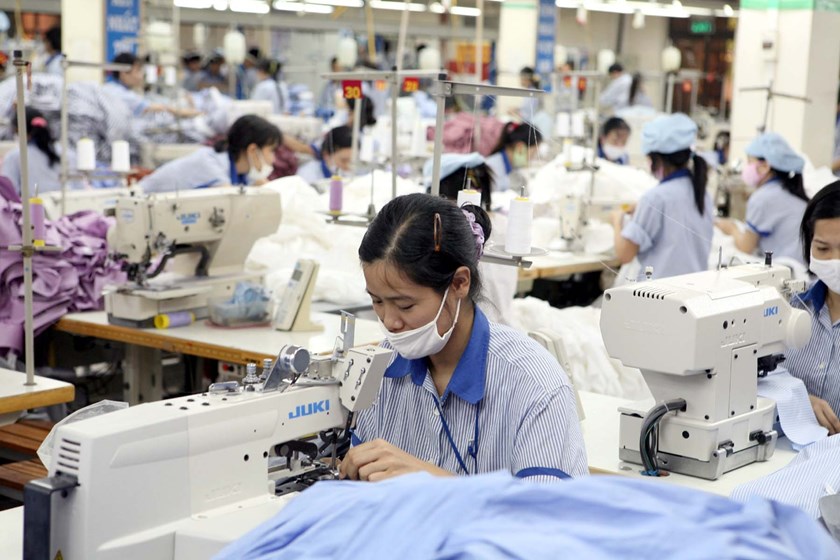Vietnam has trouble escaping dependence on China through FTAs

Thanh Nien News | July 15, 2014
Vietnam has trouble escaping dependence on China through FTAs
By Ngan Anh, Thanh Nien News
Hanoi
A host of pending trade agreements could help Vietnam reduce its heavy economic reliance on China, but won’t unless the country takes bold and difficult steps toward developing alternative supply chains and aggressively building up a domestic base range of fabric and component part manufacturers, economists said.
Vietnam is expected to sign 17 free trade agreements with 55 countries and territories by 2015.
Tariff exemptions and reductions provided by the agreements, particularly the 12-nation Trans Pacific Partnership (TPP) and the Free Trade Agreement (FTA) with the EU will allow Vietnam to import more equipment, input materials and consumer goods at better prices from first-world economies, according to Vu Tien Loc. Chairman of the Vietnam Chamber of Commerce and Industry (VCCI).
This could help Vietnam reduce its dependence on China, it’s largest trading partner by a significant margin, he said.
The TPP is expected to phase out tariffs on most goods traded between its member countries over 10 years, while the FTA with the EU will eliminate tariffs on 90 percent of Vietnamese goods.
However, it won’t be easy for local enterprises to secure alternatives to Chinese raw materials.
Former director of the Trade Research Institute, Nguyen Van Nam, said many importers of garments and footwear products are Chinese who insist that local manufacturers sign outsourcing contracts requiring them to use Chinese materials.
The director of a garment company in the Mekong Delta province of Tien Giang said 70 percent of the materials used in his firm’s production were brought in from China in 2013 and most were exported to the same country.
In order to import more materials from markets like South Korea and Thailand, his firm would have to secure garment orders from traders in those markets. Only a small segment of customers are interested in wholly-Vietnamese products, he said.
Meanwhile, cheap Chinese materials and equipment remain the preference of most local manufacturers, especially small and medium-sized firms with limited financial resources. Given the poor state of Vietnam’s fabric, component and raw material sector, low-cost alternatives to Chinese outsourcing contracts seem unattainable in the short term, Nam said.
Nam warned that Vietnam may find it hard to capitalize on these agreements at all given the fact that it has largely failed to take full advantage of the opportunities afforded by its FTA with ASEAN and the WTO.
“All firms can see benefits from tariff reduction under the future agreements. However, there are concerns about technical barriers, such as criteria on product quality, food safety, and intellectual property protection, that members like the US and EU could use to limit imports from developing countries," he said.
"It is very difficult for local firms, with their current limited financial capacity and poor production technology, to meet the minimum standards set out under those agreements," he said, citing as example the fact that local garment factories don’t have access to the locally-produced fabrics required by the EU and TPP members.
Vietnam’s exports to China in 2013 topped $10 billion, accounting for 9 percent of Vietnam’s total shipments abroad, while imports from the country reached some $30 billion, according to the Ministry of Industry and Trade.
Weak supporting industries
To reduce its reliance on China, Vietnam’s long-term strategy must involve improving local supporting industries. Despite being a major concern for investors, this issue hasn’t been ignored for years, Nam said.
Le Quang Hung, chairman of the Saigon Garment Manufacturing Trading Joint-stock Company, said Vietnamese garment producers have always sought local suppliers to reduce costs, but many components and materials cannot be found here.
Most local suppliers, especially weaving and dyeing businesses, lack the capital and technology to provide the necessary materials to garment producers, he said.
The situation has been seen in many other sectors. A dearth of supporting industries has also left Vietnamese manufacturers in trouble.
Nguyen Mai, former vice minister of the Planning and Investment, said most developing countries see their supporting industries kick in after five or 10 years of industrialization, but Vietnam’s has been stuck in assembly-mode for more than 30 years.
He blamed the government for failing to implement policies that facilitate the development of component and equipment factories.
Economist Dinh The Hien said state-owned corporations involved in key sectors of the economy want to participate in all stages of their production chain, instead of ordering spare parts for their products from private small-and medium-sized enterprises components.
“It is one of the factors hindering the development of the local supporting industries,” he said.
While local enterprises were shut out of supporting industries due to weak technology and limited capital capacity, plus a shortage of government support, foreign firms haven’t gotten involved due to the generally small scale of the market.
Mai said the government needs to define which supporting industries Vietnam will elevate in the coming years and build specific policies to develop them.
“There is a trend toward tax reduction in the world, so Vietnam doesn’t have much time to develop its supporting industry. The most essential thing now is to define a concrete action plan - where, when, and what to do - and implement it well.”
Economic growth is likely to tumble to 4.15-4.88 percent this year from last year’s modest 5.42 percent due to Vietnam’s deteriorating relationship with China, according to the Vietnam Center for Economic and Policy Research.





